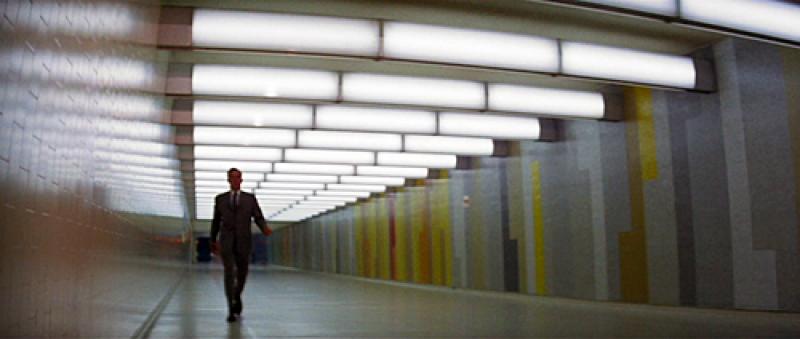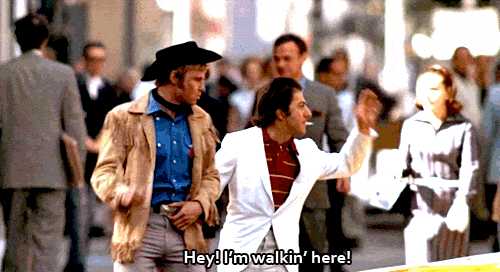Whether "Jackie Brown" or "Forrest Gump" - there are countless films with legendary running scenes. Here we present our favorites.
For most people, it's one of the most everyday things of all, so it's hardly surprising that movies are also filled from front to back with shots of walking. People walk on streets, through buildings, in fields, they run away from something or run towards something, they strut, prance, stroll, hobble or creep. In some productions, however, the human walk is even more than mere locomotion - it conveys to the audience something about the characters, the plot, emotional states, sometimes even views of the world itself. Twelve film scenes, from the classic hedonistic slow-mo walk to revenge campaigns and self-empowerment to the soul cry of all pedestrians of this world.
Point Blank (John Boorman)
The plot of “Point Blank” (1976) can essentially be summed up in one word: revenge. After a joint robbery, one gangster turns on the other, disappears with the stolen money and the other man’s wife, and thus quite literally sets the revenge campaign in motion: Walker (Lee Marvin) is the name of the crook hell-bent on revenge, and it’s hard to think of a more fitting name for him. In a brilliantly edited sequence at the beginning of the film, the director Boorman encapsulates the fast-paced action in Walker’s walking: With a determined gaze and a sure-footed step, he marches through an underpass, the clacking of his shoes fabricating the monotonous marching music that provides the soundtrack to the scene here. Again and again, the steps resound in the montage of flashbacks and flashforwards that follows, in which we see Walker’s wife and Walker himself, a “one man army” that no one can stop.

image via theartsdesk.com
Jackie Brown (Quentin Tarantino)
In the full three-minute title sequence of his 1997 film “Jackie Brown”, Quentin Tarantino combines all conceivable types of walking in one single sequence: To the sounds of the soul hit “Across 110th Street”, flight attendant Jackie Brown (Pam Grier) is brought into frame via a moving walkway and is henceforth accompanied by the camera. Arriving at the end of the walkway, she walks steadily along the lengthy aisles of the airport, eventually quickening her pace before starting to run. In combination with Bobby Womack’s song, which deals with the harsh reality of the street in an African-American neighborhood, the walk, evolving from cool nonchalance to the final sprint, already tells us everything about the protagonist that will follow in the cinematic narration.

After Hours (Martin Scorsese)
With no money and no idea exactly where he is, the ever more despairing data processor Paul Hackett (Griffith Dunne) wanders through nighttime New York with one goal: to finally make it home. The evening started out well, as after another boring day at work he met Marcy (Rosanna Arquette) in a diner, who out of the blue invited him to the studio of an artist friend in Lower Manhattan. In the mad dash of the taxi ride there, however, he loses his last 20-dollar bill, and so after the bizarre visit to the studio the unlucky guy has only one way of making it home: walking. Yet Paul cannot find his way out of the labyrinth-like neighborhood and ends up in ever more absurd scenarios, until he ultimately has to run for his life, pursued by an angry mob. To the fleeing pedestrian, the city appears like a merciless monster from which there is no shelter and no escape, while the pulsating synthesizer arpeggio of the soundtrack evokes memories of John Carpenter’s horror film music.

Martha (Rainer Werner Fassbinder)
In his 1974 psychodrama “Martha”, Rainer Werner Fassbinder explored the horror-like tendencies of middle-class marriage in the Federal Republic of Germany: Librarian Martha (Margit Carstensen) meets Helmut (Karl-Heinz Böhm) by chance in front of the German embassy in Rome and marries him a short while later. As early as the honeymoon, however, the charismatic man reveals himself to be a sadistic tyrant, who increasingly harasses, oppresses, and torments Martha in every conceivable aspect of her life.
Together with his cameraman Michael Ballhaus, Fassbinder stages the first encounter between Martha and Helmut as an impressive scene that made film history. Martha gets out of a cab, and Helmut catches sight of her from a distance. They finally walk towards each other and shortly before they meet on the same level, both begin to turn around each other and around themselves, while the camera itself circles the protagonists on a 360° track. Simply through the characters’ steps and the camera, entirely without music, Fassbinder narrates what cannot be captured in words: a fateful meeting, the dance on the edge of the abyss.

Forrest Gump (Robert Zemeckis)
Naturally, any list of famous running scenes would not be complete without the film that gave rise to the cry “Run, Forrest, run!”: Robert Zemeckis’ “Forrest Gump” from 1994, in which the eponymous hero, sitting on a park bench, recounts his entire life to passersby. There are several scenes devoted to running: At the beginning of the film, the young Forrest Gump, whose running is severely impaired by his leg braces, flees from three school bullies. To the sounds of heroic orchestral music by Alan Silvestri, the young Forrest sheds his bothersome walking aids as he flees and discovers with surprise that he can run, he can run really fast. Zemeckis repeats the scene almost identically once Forrest is grown up as he again flees from bullies, and his running ability subsequently lands him a successful football career. And then, of course, there is the almost seven-minute montage in which Forrest Gump spends almost three years running right across the USA. It is running as empowerment, as meditation, as self-discovery.


A Life Aquatic (Wes Anderson)
In virtually every Wes Anderson film there is at least one slow-motion sequence, in which the protagonists are almost invariably shown walking or running. The fact that Wes Anderson slows down precisely the moment of setting oneself in motion and thus makes it all the more of a focus can be attributed to the special importance the director seems to attribute to human locomotion: It always follows a moment of catharsis for the protagonists, as is the case in the closing scene of the bizarrely sad “A Life Aquatic” from 2004. After oceanographer Steve Zissou (Bill Murray) overcomes his personal crisis in the course of the film, in the end he leaves a press conference followed by an entourage of better-off people whose approval he has sought for so long. While David Bowie’s driving “Queen Bitch” plays on the soundtrack, the image slows down and shows the aging man, broken, but at peace with himself and henceforth united with his family of choice. A walk into a new life.

© Phillippe Antonello, Touchstone Pictures, image via imdb.com
La Notte (Michelangelo Antonioni)
“La Notte” is the second part of a trilogy in which Antonioni intensively explores human isolation. At the beginning of this 1961 film, a married couple who have been drifting apart for years goes to visit a terminally ill friend in a clinic in Milan. The visit makes a profound impression on the woman (Jeanne Moreau), who then goes walking alone through the streets of the city. Lost in her thoughts, she wanders through the almost deserted city center, where only her footsteps, sirens, and airplane noises – but no other people – can be heard. The sensory impressions seem almost unbearable for the protagonist, and she eventually takes a taxi out to a suburb. In her aimless wandering through broken streets, debris, and fields, she watches people going about their senseless business there. The walk appears to bring out the woman’s long-suppressed emotional isolation, which is irreversible: There is no escape from the inner emptiness, especially not within manmade urbanity.
The walk seems to bring out the long repressed emotional isolation of the woman, which is irreversible

image via leoninefilms.com
The list could go on and on, as there are countless films with legendary running scenes: Consider, for example, Silvester Stallone’s heroic run through Philadelphia in “Rocky II” and the opening sequence of “Saturday Night Fever”, in which John Travolta struts through the streets of Brooklyn – and is even filmed, as he does so, from below in a funky camera perspective. Also not to be forgotten is Angie Dickinson’s walk through New York’s Metropolitan Museum of Art in “Dressed to Kill”, the depiction of wandering pilgrims in Kelly Reichardt’s post-Western “Meek’s Cutoff”, or Dustin Hoffman and Jon Voight’s jaunts through the filthy New York of the late 1960s in “Midnight Cowboy” – complete with an angry “I’m walking here!”, the soul cry of all pedestrians of this world who, like Hoffman here, find themselves almost hit by a car.










